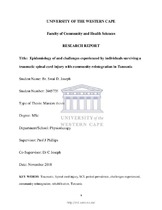| dc.description.abstract | A traumatic spinal cord injury (TSCI) often occurs unexpectedly and causes considerable disability. This condition requires specialized care that is delivered in a time sensitive manner. Data on the incidence, causes, mortality and injury characteristics of TSCI are important for gauging demand for health care and social support services. Unfortunately data on the incidence and causes, as well as functioning such as participation and integration into society, of TSCI are sparse in developing countries such as Tanzania. The overall aim of this study is to determine the incidence, causes, mortality and injury characteristics of TSCI, and to explore the challenges experienced with community reintegration after injury in Tanzania. Both quantitative and qualitative research paradigms were used. The quantitative phase of the study was conducted at Kilimanjaro Christian Medical Centre (KCMC), a referral and teaching hospital in northern Tanzania. The study population was all patients admitted to KCMC with a TSCI from 1 January 2011 to 31 December 2015 (five year period). Quantitative data were collected retrospectively using a data extraction sheet designed by the International Spinal Cord Society which consisted of the following sections: participants’ characteristics (for example age, gender, duration of hospital stay, causes of injury and vertebral injuries) and injury characteristics (location of injury and completeness of injury). Differences between groups (stratified by year) was analysed using both descriptive and inferential statistics. The population for the qualitative phase was based on those included in the quantitative phase. Purposive sampling was used to select adults (over the age of 18 years) with TSCI who were managed at KCMC. Qualitative data were collected by means of individual, semi-structured interviews, and lasted until theoretical saturation was achieved. Thematic analysis was used to derive themes (categories) explaining the latent perceptions of community reintegration and its influences. | en_US |

